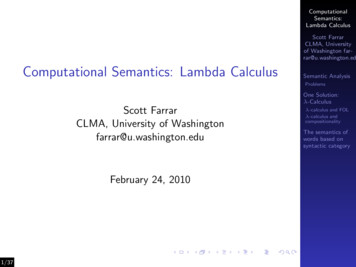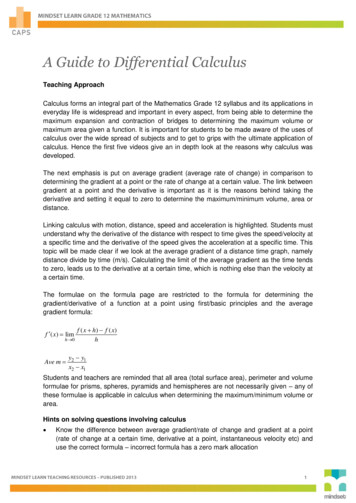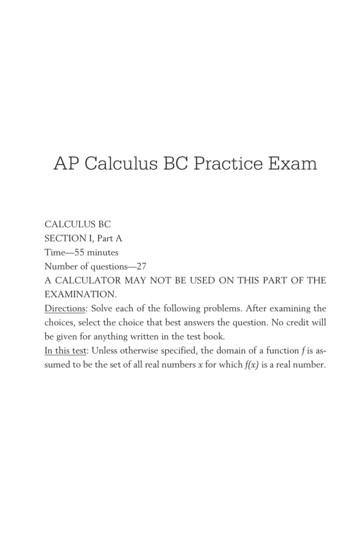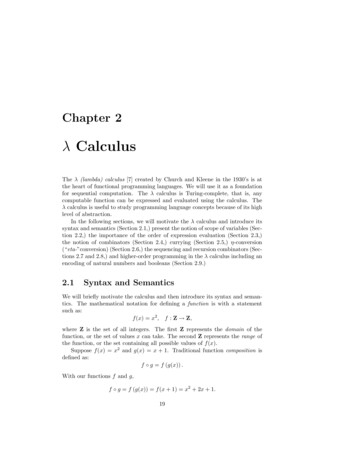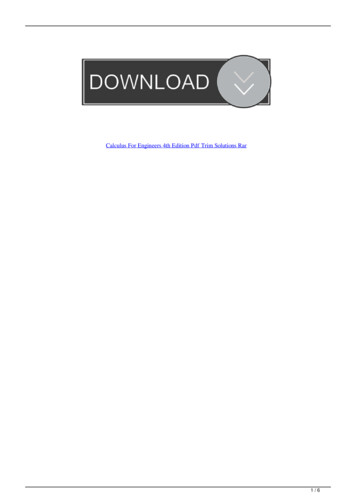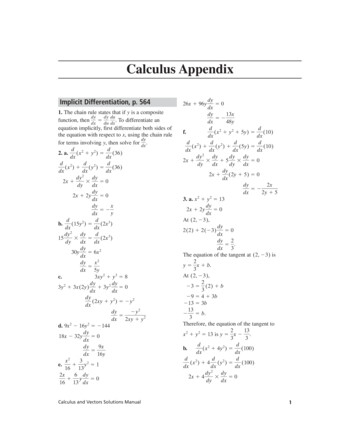
Transcription
Calculus AppendixImplicit Differentiation, p. 5641. The chain rule states that if y is a compositedydy dufunction, then dx 5 du dx . To differentiate anequation implicitly, first differentiate both sides ofthe equation with respect to x, using the chain ruledyfor terms involving y, then solve for dx.dd2. a. (x 2 1 y 2 ) 5 (36)dxdxd 2d 2d(x ) 1(y ) 5(36)dxdxdxdy 2dy2x 1350dydxdy502x 1 2ydxdyx52ydxddb.(15y 2 ) 5(2x 3 )dxdxdy 2dyd1535(2x 3 )dydxdxdy30y5 6x 2dxdyx25dx5y3xy 2 1 y 3 5 8c.dydy1 3y 2503y 2 1 3x(2y)dxdxdy(2xy 1 y 2 ) 5 2y 2dx2y 2dy5dx2xy 1 y 2d. 9x 2 2 16y 2 5 2144dy18x 2 32y50dx9xdy5dx16yx23 21 y 51e.16136 dy2x1 y501613 dxCalculus and Vectors Solutions Manualdy50dxdy13x52dx48yd 2d(x 1 y 2 1 5y) 5(10)f.dxdxd 2d 2dd(x ) 1(y ) 1(5y) 5(10)dxdxdxdxdy 2dydydy2x 1315350dydxdydxdy2x 1(2y 1 5) 5 0dxdy2x52dx2y 1 53. a. x 2 1 y 2 5 13dy2x 1 2y50dxAt (2, 23),dy2(2) 1 2(23)50dxdy25 .dx3The equation of the tangent at (2, 23) is2y 5 x 1 b.3At (2, 23),223 5 (2) 1 b329 5 4 1 3b213 5 3b132 5 b.3Therefore, the equation of the tangent to213x 2 1 y 2 5 13 is y 5 x 2 .33d 2d(x 1 4y 2 ) 5(100)b.dxdxddd 2(x ) 1 4 (y 2 ) 5(100)dxdxdxdy 2dy2x 1 4350dydx26x 1 96y1
dy50dxxdy52dx4yAt the point (28, 3), the slope of the tangent is2x 1 8ydy2therefore 5 2 428The equation of the(3) 5 3 .dxtangent line is therefore2y 5 (x 1 8) 1 33x2y225 21c.25362x2y dy2502536 dxdy36x 2 25y50dxAt (5 !3, 212),dy180!3 1 30050dxdy3 !352.dx5The equation of the tangent is y 5 mx 1 b.At (5 !3, 212) and with m 5 2 3 !35 ,3!3212 5 2(5 !3) 1 b5212 5 29 1 b23 5 bTherefore, the equation of the tangent is3"3y52x 2 3.5d x25y 2dd.a 2b5(1)dx 81162dx1 d5 d 2da b (x 2 ) 2 ab (y ) 5(1)81 dx162 dxdx15 dy 2dya b2x 2 ab35081162 dydx25 dyx2 y508181 dxdy2x5dx5yAt the point (211, 24), the slope of the tangent isthereforedy52 (211)5 (24)The equation of the5 1110 .tangent line is therefore11y 5 (x 1 11) 2 4102dx4. x 1 y 2 5 1The line x 1 2y 5 0 has slope of 2 12.dy501 1 2ydxSince the tangent line is parallel to x 1 2y 5 0, thendy5 2 12.dx11 1 2ya2 b 5 0212y50y51Substituting,x1151x50Therefore, the tangent line to the curve x 1 y 2 5 1is parallel to the line x 1 2y 5 0 at (0, 1).5. a. 5x 2 2 6xy 1 5y 2 5 16dydy10x 2 a6y 1(6x)b 1 10y5 0(1)dxdxAt (1, 21),dydy10 2 a26 1 6 b 2 1050dxdxdy16 2 1650dxdy5 1.dxdyb. When the tangent line is horizontal, dx 5 0.Substituting,10x 2 (6y 1 0) 1 0 5 0.y 5 53 x at the point (x1, y1 ) of tangency:substitute y1 5 53 x1 into 5x21 2 6x1 y1 1 5y21 5 16.5255x21 2 6x1 a x1 b 1 5a x21 b 5 163945x21 2 90x21 1 125x21 5 14480x21 5 1445x21 5 933or x1 5 2x1 5!5!55or y1 5 !5y1 5!55or y1 5 2 !5y1 5 2!5Therefore, the required points are !5, "5 and32 !5, 2"5 .()(3)Calculus Appendix
6. 5x 2 1 y 2 5 21dy5010x 1 2ydxdy5x52ydxdy21052At (22, 21),or 210.dx21The slope of the tangent line to the ellipse at(22, 21) is 210.x 3 1 y 3 2 3xy 5 177.dydy3x 2 1 3y 2 2 c 3y 1(3x) d 5 0dxdxAt (2, 3),dydy12 1 27292650dxdxdy21 5 23.dxdyThe slope of the tangent is 5 2 17.dxTherefore, the slope of the normal at (2, 3) is 7.dd("x 1 y 2 2x) 5(1)dxdxddd1( (x 1 y)2 ) 2(2x) 5(1)dxdxdx1d1(x 1 y)22 3(x 1 y) 2 2 5 02dx1dy1(x 1 y)22 a1 1b522dxdy5 4"x 1 y 2 1dx10. 4x 2y 2 3y 5 x 3dydya. 8xy 1(4x 2 ) 2 35 3x 2dxdxdy(4x 2 2 3) 5 3x 2 2 8xydxdy3x 2 2 8xy(1)5dx4x 2 2 3b. y(4x 2 2 3) 5 x 3b.x34x 2 3dy3x 2 (4x 2 2 3) 2 8x(x 3 )5dx(4x 2 2 3)2y5y23The equation of the normal at (2, 3) is x 2 2 5 7y 2 3 5 7x 2 14 or 7x 2 y 2 11 5 0d 2dx38.(y ) 5abdxdx 2 2 xdy 2dy(2 2 x)(3x 2 ) 2 x 3 (21)35dydx(2 2 x)2dy6x 2 2 2x 32y5dx(2 2 x)2dy3x 2 2 x 35dxy(2 2 x)2dy3(1)2 2 (1)3At (1, 21),55 22dx(21)(2 2 1)2The slope of the normal is 12. The equation of thenormal at (1, 21) is y 2 (21) 5 12 (x 2 1) ory 5 12 x 2 32.dd9. a.(x 1 y)3 5(12x)dxdxd3(x 1 y)2 3(x 1 y) 5 12dxdy3(x 1 y)2 a1 1b 5 12dx4dy521dx(x 1 y)2Calculus and Vectors Solutions Manual5212x 4 2 9x 2 2 8x 4(4x 2 2 3)24x 4 2 9x 2(4x 2 2 3)2c. We must show that (1) is equivalent to (2).5dy(2)3x 2 2 8xyFrom (1): dx 5 4x 2 2 3 and substituting,y5x34x 2 323x 2 2 8xa 4x 2 2 3 bx3dy5dx4x 2 2 33x 2 2 (4x 2 2 3) 2 8x 45(4x 2 2 3)212x 4 2 9x 2 2 8x 45(4x 2 2 3)24x 4 2 9x 255 (2), as required.(4x 2 2 3)23
11. a.13.yP (4, 6)(0, 2)QThere is one tangent when x 5 1.b.A(4, 0)(–4, 0)x(0, –2)There is one tangent when x 5 1.c.There is one tangent when x 5 1.d.There are two tangents when x 5 1.dyyyx12.15 10, x 2 y 2 0,5xdxÄy Äxdydy111 y 22 dx x 2 y1 x 22 1y 2 dxx501 a ba bx22 x2 yy212dy1y 2 xdx12dyx2ydxyx1 150122yx22x2y2Multiply by 2x 2y 2:dydy3 11 3x2y2 ay 2 x b 1 x2y2 a x 2 yb 5 0dxdx3 35 1 dy3 3 dy1 5x 2y 2 2 x 2y 21 x 2y 22 x 2y 2 5 0dxdxdy 32 323 11 33 3Q x y 2 x2y2 R 5 x2y 2 2 x 2y2dx1 3x 2y 2 (y 2 x)dy5 1 1dxx 2y 2 (y 2 x)Let Q have coordinates"16 2 q 2(q, f(q)) 5 aq,b, q , 0.2For x 2 1 4y 2 5 16dy2x 1 3y50dxdyx52 .dx4yqdyAt Q,52dx2 !16 2 q 2y26The line through P has equation x 2 4 5 m.Since PQ is the slope of the tangent line tox 2 1 4y 2 5 16, we conclude:dyat point Q.m5dx"16 2 q 2262q2452q2"16 2 q 29"16 2 q 2 2 12522(q 2 4)2"16 2 q 216 2 q 2 2 12"16 2 q 2 5 2q(q 2 4)16 2 q 2 2 12"16 2 q 2 5 2q 2 1 4q4 2 q 5 3"16 2 q 216 2 8q 1 q 2 5 9(16 2 q 2 )16 2 8q 1 q 2 5 144 2 9q 210q 2 2 8q 2 128 5 05q 2 2 4q 2 64 5 0(5q 1 16)(q 2 4) 5 0q 5 2 165 or q 5 4 (as expected; see graph)f(q) 5 65 or f(q) 5 0dyy5 , as required.xdx4Calculus Appendix
16dy5 56 or f(q) 5 0dx4Q5 R23y26Equation of the tangent at Q is x 2 4 5 23 or2x 2 3y 1 10 5 0 or equation of tangent at A isx 5 4.14.yxy px2 – y2 k5P(a, b)0x2 – y2 kxxy pLet P(a, b) be the point of intersection where a 2 0and b 2 0.For x 2 2 y 2 5 kdy502x 2 2ydxdyx5ydxAt P(a, b),dya5 .dxbFor xy 5 P,dyx5P1?y1dxydy52xdxAt P(a, b),dyb52 .adxAt point P(a, b), the slope of the tangent line ofxy 5 P is the negative reciprocal of the slope of thetangent line of x 2 2 y 2 5 k. Therefore, the tangentlines intersect at right angles, and thus, the twocurves intersect orthogonally for all values of theconstants k and P.15. !x 1 !y 5 !kDifferentiate with respect to x:1 121 1 dyx 1 y25022 dxdy!y52dx!xCalculus and Vectors Solutions ManualLet P(a, b) be the point of tangency.!bdy2dx!aEquation of tangent line l at P isy2b!b.52x2a!ax-intercept is found when y 5 0.2b!b52x2a!a2b!a 5 2 !bx 1 a !ba !b 1 b!ax5!ba !b 1 b !a.!bTherefore, the x-intercept isFor the y-intercept, let x 5 0,y2b!b.522a!aa !b1 b.y-intercept is!aThe sum of the intercepts isa !b 1 b!aa!b 1 b!a1!b!a3131a 2 b2 1 2ab 1 b 2 a 251 1a 2b 211a 2 b 2 (a 1 2"a"b 1 b)511a2 b25 a 1 2"a"b 1 b115 (a 2 1 b2 )2Since P(a, b) is on the curve, then!a 1 !b 5 !k, or a2 1 b2 5 k2.Therefore, the sum of the intercepts is 5 k,as required.16.y111y2 4x(–2, 5)(1, 2)(4, –1)xx y –35
y 2 5 4xdy2t54dxdyAt (1, 2),5 1.dxTherefore, the slope of the tangent line at (1, 2) is 1and the equation of the normal isy225 21 or x 1 y 5 3.x21The centres of the two circles lie on the straight linex 1 y 5 3. Let the coordinates of the centre of eachcircle be (p, q) 5 (p, 3 2 p). The radius of eachcircle is 3!2. Since (1, 2) is on the circumferenceof the circles,(p 2 1)2 1 (3 2 p 2 2)2 5 r 2p 2 2 2p 1 1 1 1 2 2p 1 p 2 5 (3 !2)22p 2 2 4p 1 2 5 18p 2 2 2p 2 8 5 0(p 2 4)(p 1 2) 5 0p 5 4 or p 5 22q 5 21 or q 5 5.Therefore, the centres of the circles are (22, 5) and(4, 21). The equations of the circles are(x 1 2)2 1 (y 2 5)2 5 18 and(x 2 4)2 1 (y 1 1)2 5 18.dT(x)dx5 2200(1 1 x 2 )22 2xdtdt2400xdx5? .(1 1 x 2 )2 dtAt a specific time, when x 5 5,dT(5)2400(5)5(2)dt(26)2240005676210005169dT(5)8 25.9.dtTherefore, the temperature is decreasing at a rate of5.9 C s.b. To determine the distance at which the temperatureis changing fastest, graph the derivative of thefunction on a graphing calculator. Since thetemperature decreases as the person moves awayfrom the fire, the temperature will be changingfastest when the value of the derivative is at itsminimum value.For Y1, enter nDeriv( from the MATH menu. Thenenter 200 4 (1 X2), X, X).Related Rates, pp. 569–570dA5 4 m s2dtdSb.5 23 m2 min.dtds5 70 km h when t 5 0.25c.dtdxdy5d.dtdtdup5e.rad sdt102002. T(x) 51 1 x2dx5 2 m sa.dt1. a.dT(x)dtwhen x 5 5 m:200T(x) 51 1 x25 200(1 1 x 2 )21Find6The temperature is changing fastest at about 0.58 m.c. Solve Ts (x) 5 0.2400xTr(x) 5(1 1 x 2 )22400(1 1 x 2 )2 2 2(1 1 x 2 )(2x)(2400x)Tr(x) 5(1 1 x 2 )4Let Ts (x) 5 0,2400(1 1 x 2 )2 1 1600x 2 (1 1 x 2 ) 5 0.Divide,400(1 1 x 2 ) 2 (1 1 x 2 ) 1 4x 2 5 03x 2 5 11x2 5!31x5!3x . 0 or x 8 0.58.Calculus Appendix
y 2 5 4xdy2t54dxdyAt (1, 2),5 1.dxTherefore, the slope of the tangent line at (1, 2) is 1and the equation of the normal isy225 21 or x 1 y 5 3.x21The centres of the two circles lie on the straight linex 1 y 5 3. Let the coordinates of the centre of eachcircle be (p, q) 5 (p, 3 2 p). The radius of eachcircle is 3!2. Since (1, 2) is on the circumferenceof the circles,(p 2 1)2 1 (3 2 p 2 2)2 5 r 2p 2 2 2p 1 1 1 1 2 2p 1 p 2 5 (3 !2)22p 2 2 4p 1 2 5 18p 2 2 2p 2 8 5 0(p 2 4)(p 1 2) 5 0p 5 4 or p 5 22q 5 21 or q 5 5.Therefore, the centres of the circles are (22, 5) and(4, 21). The equations of the circles are(x 1 2)2 1 (y 2 5)2 5 18 and(x 2 4)2 1 (y 1 1)2 5 18.dT(x)dx5 2200(1 1 x 2 )22 2xdtdt2400xdx5? .(1 1 x 2 )2 dtAt a specific time, when x 5 5,dT(5)2400(5)5(2)dt(26)2240005676210005169dT(5)8 25.9.dtTherefore, the temperature is decreasing at a rate of5.9 C s.b. To determine the distance at which the temperatureis changing fastest, graph the derivative of thefunction on a graphing calculator. Since thetemperature decreases as the person moves awayfrom the fire, the temperature will be changingfastest when the value of the derivative is at itsminimum value.For Y1, enter nDeriv( from the MATH menu. Thenenter 200 4 (1 X2), X, X).Related Rates, pp. 569–570dA5 4 m s2dtdSb.5 23 m2 min.dtds5 70 km h when t 5 0.25c.dtdxdy5d.dtdtdup5e.rad sdt102002. T(x) 51 1 x2dx5 2 m sa.dt1. a.dT(x)dtwhen x 5 5 m:200T(x) 51 1 x25 200(1 1 x 2 )21Find6The temperature is changing fastest at about 0.58 m.c. Solve Ts (x) 5 0.2400xTr(x) 5(1 1 x 2 )22400(1 1 x 2 )2 2 2(1 1 x 2 )(2x)(2400x)Tr(x) 5(1 1 x 2 )4Let Ts (x) 5 0,2400(1 1 x 2 )2 1 1600x 2 (1 1 x 2 ) 5 0.Divide,400(1 1 x 2 ) 2 (1 1 x 2 ) 1 4x 2 5 03x 2 5 11x2 5!31x5!3x . 0 or x 8 0.58.Calculus Appendix
x dt 5 5 cm s.dx3. Given squarexdAFind dt when x 5 10 cm.SolutionLet the side of a square be x cm.A 5 x2dAdx5 2xdtdtAt a specific time, x 5 10 cm.dA5 2(10)(5)dt5 100Therefore, the area is increasing at 100 cm2 swhen a side is 10 cm.P 5 4xdxdP54dtdtdxAt any time, dt 5 5.dP5 20.dtTherefore, the perimeter is increasing at 20 cm s.4. Given cube with sides x cm,dva. Find dt when x 5 5 cm:dx55dtcm s.V 5 x3dVdx5 3x 2dtdtAt a specific time, x 5 5 cm.dV5 3(5)2 (4)dt5 300Therefore, the volume is increasing at 300 cm3 s.dSb. Find dt when x 5 7 cm.S 5 6x 2dSdx5 12xdtdtAt a specific time, x 5 7 cm,dS5 12(7)(4)dt5 336.Therefore, the surface area is increasing at a rate of336 cm2 s.Calculus and Vectors Solutions Manual5. Given rectangledx5 2 cm sdtdy5 23 cm sdtyxdAFind dt when x 5 20 cm and y 5 50 cm.SolutionA 5 xydAdxdy5y1xdtdtdtAt s specific time, x 5 20, y 5 50,dA5 (2)(50) 1 (23)(20)dt5 100 2 505 40.Therefore, the area is increasing at a rate of 40 cm2 s.6. Given circle with radius r,dA5 25 m2 s.dtdra. Find dt when r 5 3 m.A 5 pr 2dAdr5 2prdtdtWhen r 5 3,25 5 2p(3)drdtdr255dt6p5Therefore, the radius is decreasing at a rate of 6p m swhen r 5 3 m.dDb. Find dt when r 5 3.dDdr52dtdt255 2ab6p2553pTherefore, the diameter is decreasing at a rate of5m s.3p7
7. Given circle with radius r, dt 5 6 km2 hdrFind dt when A 5 9p km2.A 5 pr 2dAdr5 2prdtdtWhen A 5 9p,9p 5 pr 2r2 5 9r53r . 0.When r 5 3,dA56dtdr6 5 2p(3)dtdr15 .pdt1Therefore, the radius is increasing at a rate of p km h.8. Let x represent the distance from the wall and ythe height of the ladder on the wall.dAyr9.xykiterLet the variables represent the distances as shownon the diagram.x2 1 y2 5 r2dxdydr2x1 2y5 2rdtdtdtdxdydrx1y5rdtdtdtx 5 30, y 5 40r 2 5 302 1 402r 5 50dydrdx5 ?,5 10,50dtdtdtdr30(10) 1 40(0) 5 50a bdtdr58dtTherefore, she must let out the line at a rate of8 m min.10.ryx2x 1 y2 5 r2dxdydr2x1 2y5 2rdtdtdtdxdydrx1y5rdtdtdtWhen r 5 5, y 5 3,x 2 5 25 2 95 16x54x 5 4, y 5 3, r 5 5dx1 dr5 ,5 0.dt3 dtSubstituting,1dy4a b 1 3a b 5 5(0)3dtdy452 .dt9Therefore, the top of the ladder is sliding down at4 m s.8915 mLabel diagram as shown.r 2 5 y 2 1 9152drdy2r 5 2ydtdtdydrr 5ydtdtdyWhen y 5 1220, dt 5 268 m s.r 5 "12202 1 91525 1525dr1525a b 5 1220 3 268dtdr5 214 m sdtTherefore, the camera–to–rocket distance ischanging at 214 m s.Calculus Appendix
11.412. Given sphere V 5 3pr 3yStartingpoint3dV5 8 cm3 s.dtrdrxdx5 15 km hdtdy5 20 km hdtdrFindwhen t 5 2 h.dtSolutionLet x represent the distance cyclist 1 is from the starting point, x 0. Let y represent the distance cyclist2 is from the starting point, y 0 and let r be thedistance the cyclists are apart. Using the cosine law,pr 2 5 x 2 1 y 2 2 2xy cos315 x 2 1 y 2 2 2xya b2222r 5 x 1 y 2 xydrdxdydxdy2r 5 2x1 2y2 c y 1 xddtdtdtdtdtAt t 5 2 h, x 5 30 km, y 5 40 kmpand r 2 5 302 1 402 2 2(30)(40) cos 315 2500 2 2(1200)a b25 1300r 5 10"13, r . 0.dr6 2(10"13)dt5 2(30)(15) 1 2(40)(20) 2 315(40) 1 20(30)4dr20"135 900 1 1600 2 3600 2 6004dt5 1300dr1305dt2"13655"1365"135135 5"13Therefore, the distance between the cyclists isincreasing at a rate of 5"13 km h after 2 h.Calculus and Vectors Solutions Manuala. Find dt when r 5 12 cm.4V 5 pr 33dVdr5 4pr 2dtdtAt a specific time, when r 5 12 cm:dr8 5 4p(12)2dtdr8 5 4p(144)dt1dr5 .72pdtTherefore, the radius is increasing at a rate of1cm s.72pdrb. Find dt when V 5 1435 cm3.4V 5 pr 33dVdr5 4pr 2 .dtdtAt a specific time, when V 5 1435 cm3:V 5 14354 3p 5 14353r 3 8 342.581 0158 6.997 148 657dr8 8 4p(7)2dtdr8 5 196pdt2dr549pdtdr0.01 5 .dt2Therefore, the radius is increasing at 49p cm s(or about 0.01 cm s).drc. Find dt when t 5 33.5 s.When t 5 33.5, v 5 8 3 33.5 cm3:4 3pr 5 2683r 3 8 63.980 287 129
r 8 3.999 589 2738 4.4V 5 pr 33dVdr5 4pr 2dtdtAt t 5 33.5 s,dr8 8 4p(4)2dtdr8 5 64pdt1dr5 .8pdtTherefore, the radius is increasing at a rate of18pcm s (or 0.04 cm s).13. Given cylinder15 mSince dt 5 500 000 cm3 min, it takes 500 000 min,5 30p min to fill8 94.25 min.Therefore, it will take 94.25 min, or just over 1.5 hto fill the cylindrical tank.14. There are many possible problems.Samples:a. The diameter of a right-circular cone is expandingat a rate of 4 cm min. Its height remains constant at10 cm. Find its radius when the volume is increasingat a rate of 80p cm3 min.b. Water is being poured into a right-circular tank atthe rate of 12p m3 min. Its height is 4 m and itsradius is 1 m. At what rate is the water level rising?c. The volume of a right-circular cone is expandingbecause its radius is increasing at 12 cm min and itsheight is increasing at 6 cm min. Find the rate atwhich its volume is changing when its radius is20 cm and its height is 40 cm.15. Given cylinderdV15 000 000p2mV 5 pr 2hdV5 500 L mindt5 500 000 cm mindhFind .dtV 5 pr 2hSince the diameter is constant at 2 m, the radius isalso constant at 1 m 5 100 cm.V 5 10 000phdVdh5 10 000pdtdtdh500 000 5 10 000pdt50dh5pdtTherefore, the fluid level is rising at a rate of50pcm min.Find t, the time of fill the cylinder.V 5 pr 2hV 5 p(100)2 (1 500) cm3V 5 150 000 00p cm310d51mh 5 15 mdr5 0.003 m yeardtdh5 0.4 m yeardtdVFind dt at the instant D 5 1V 5 pr 2hdVdrdh5 a2pr b (h) 1 a b (pr 2 ).dtdtdtAt a specific time, when D 5 1; i.e., r 5 0.5,dV5 2p(0.5)(0.003)(15) 1 0.4p(0.5)2dt5 0.045p 1 0.1p5 0.145pTherefore, the volume of the trunk is increasing at arate of 0.145p m3 year.Calculus Appendix
16. Given coneh25 cm15 cmr 5 5 cmh 5 15 cmdV5 2 cm3 mindtdhFind dt when h 5 3 cm,1V 5 pr 2h.3rUsing similar triangles, h 5 155 5 13hr5 .3Since the cross section is equilateral, V 53 l."3h2V53 5."3dV10 dh5hdt"3 dtAt a specific, time when h 5 0.1 5 101 ,10 1 dh0.25 5"3 10 dtdh0.25"3 5dt"3dh54dtTherefore, the water level is rising at a rate of"34 m min.18.Substituting into V 5 13pr 2h,1h2V 5 pa bh3915 ph 327dV1dh5 ph 2dt9dtAt a specific time, when h 5 3 cm,1dh22 5 p(3)29dt2dh2 5.pdtTherefore, the water level is being lowered at a1.8yxdy5 120 m mindtdxFindwhen t 5 5 s.dtLet x represent the length of the shadow. Let yrepresent the distance the man is from the base ofthe lamppost. Let h represent the height of thelamppost. At a specific instant, we haverate of p cm min when height is 3 cm.217. Given troughh1.8125 cm5mdVm35 0.25dtmindhFind dt when h 5 10 cm5 0.1 m.Calculus and Vectors Solutions Manualx y1.2Using similar triangles,x1y1.25h1.82.225h32h 5 6.6h 5 3.3Therefore, the lamppost is 3.3 m high.11
At any time,x1y3.35x1.8x1y115x66x 1 6y 5 11x6y 5 5xdydx655 .dtdtAt a specific time, when t 5 5 secondsdy5 120dtm min,6 3 120 5 5dxdtdx5 144.dtTherefore, the man’s shadow is lengthening at a rateof 144 m min after 5 s.19. This question is similar to finding the rate ofchange of the length of the diagonal of a rectangularprism.AFGBHECD2020 m 5km10001km550Findd(GH)dtat t 5 10 s,1h.360Let BG be the path of the train and CH be the pathof the boat:Using the Pythagorean theorem,GH 2 5 HD 2 1 DG 2 and HD 2 5 CD 2 1 CH 2GH 2 5 CD 2 1 CH 2 1 DG 2Since BG 5 CD and FE 5 GD 5 501 , it follows that1GH 2 5 BG 2 1 CH 2 1.2500d(GH)d(BG)d(CH)2(GH)5 2(BG)1 2(CH)dtdtdtAt t 5 10 s,d(GH)11GH5 (60) 1 (20)dt618"6331 d(GH)1005450dt9d(GH)450005dt9"63318 62.8.1 21 21 2And GH 2 5 a b 1 a b 1 a b61850111511363242500911 66451829 160 000113 958GH 2 51 18364 50063315202 500"6331"13 3 487GH 55450450Therefore, they are separating at a rate ofapproximately 62.8 km h.20. Given coner5d(CH)d(BG)5 60 km h and5 20 km h.dtdtAt t 51211h, BG 5 60 336036015 km61and CH 5 20 33601km.518ha. r 5 hdV5 200 2 20dt5 180 cm3 sdhFind dt when h 5 15 cm.1V 5 pr 2h and r 5 h31V 5 ph 3.3dVdh5 ph 2dtdtCalculus Appendix
At a specific time, h 5 15 cm.dh180 5 p(15)2dtdh45dt5pTherefore, the height of the water in the funnel isincreasing at a rate of 5p cm s.ykP(x, y)l–k4b. dt 5 200 cm3 sdhFind dt when h 5 25 cm.0dVdVdh5 ph 2 .dtdtAt the time when the funnel is clogged, h 5 25 cm:dh200 5 p(25)2 .dtdh85.dt25pTherefore, the height is increasing at 25p cm s.21.y8xLet P(x, y) be a general point on the ladder adistance k from the top of the ladder. Let A(a, 0) bethe point of contact of the ladder with the ground.axxlFrom similar triangles, l 5 k or a 5 k .Using the Pythagorean Theorem:xly 2 1 (a 2 x)2 5 (l 2 k)2, and substituting a 5 k ,2xly 2 1 a 2 xb 5 (l 2 k)2ky2 1 x2 al2k 2b 5 (l 2 k)2k(l 2 k)2 2x 1 y 2 5 (l 2 k)2k2x2y215 1 is the required equation.k2(l 2 k)2Therefore, the equation is the first quadrant portionof an ellipse.B(0, 2y)M(x, y)0A(a, 0)xA(2x, 0)Let the midpoint of the ladder be (x, y). Fromsimilar triangles, it can be shown that the top of theladder and base of the ladder would have pointsB(0, 2y) and A(2x, 0) respectively. Since the ladderhas length l,(2x)2 1 (2y)2 5 l 24x 2 1 4y 2 5 l 2l2x2 1 y2 54l 25 a b is the required equation.2Therefore, the equation of the path followed by themidpoint of the ladder represents a quarter circlelwith centre (0, 0) and radius 2, with x, y 0.Calculus and Vectors Solutions ManualThe Natural Logarithm and itsDerivative, p. 5751. A natural logarithm has base e; a commonlogarithm has base 10.112. Since e 5 lim (1 1 h) n , let h 5 n. Therefore,hS0ne 5 lim a1 1 1 b ,1 S0nnBut as1S 0, n S .n1 nTherefore, e 5 lim a1 1 b .nnS 1 100bIf n 5 100, e 8 a1 11005 1.011008 2.70481.Try n 5 100 000, etc.13
At a specific time, h 5 15 cm.dh180 5 p(15)2dtdh45dt5pTherefore, the height of the water in the funnel isincreasing at a rate of 5p cm s.ykP(x, y)l–k4b. dt 5 200 cm3 sdhFind dt when h 5 25 cm.0dVdVdh5 ph 2 .dtdtAt the time when the funnel is clogged, h 5 25 cm:dh200 5 p(25)2 .dtdh85.dt25pTherefore, the height is increasing at 25p cm s.21.y8xLet P(x, y) be a general point on the ladder adistance k from the top of the ladder. Let A(a, 0) bethe point of contact of the ladder with the ground.axxlFrom similar triangles, l 5 k or a 5 k .Using the Pythagorean Theorem:xly 2 1 (a 2 x)2 5 (l 2 k)2, and substituting a 5 k ,2xly 2 1 a 2 xb 5 (l 2 k)2ky2 1 x2 al2k 2b 5 (l 2 k)2k(l 2 k)2 2x 1 y 2 5 (l 2 k)2k2x2y215 1 is the required equation.k2(l 2 k)2Therefore, the equation is the first quadrant portionof an ellipse.B(0, 2y)M(x, y)0A(a, 0)xA(2x, 0)Let the midpoint of the ladder be (x, y). Fromsimilar triangles, it can be shown that the top of theladder and base of the ladder would have pointsB(0, 2y) and A(2x, 0) respectively. Since the ladderhas length l,(2x)2 1 (2y)2 5 l 24x 2 1 4y 2 5 l 2l2x2 1 y2 54l 25 a b is the required equation.2Therefore, the equation of the path followed by themidpoint of the ladder represents a quarter circlelwith centre (0, 0) and radius 2, with x, y 0.Calculus and Vectors Solutions ManualThe Natural Logarithm and itsDerivative, p. 5751. A natural logarithm has base e; a commonlogarithm has base 10.112. Since e 5 lim (1 1 h) n , let h 5 n. Therefore,hS0ne 5 lim a1 1 1 b ,1 S0nnBut as1S 0, n S .n1 nTherefore, e 5 lim a1 1 b .nnS 1 100bIf n 5 100, e 8 a1 11005 1.011008 2.70481.Try n 5 100 000, etc.13
dyd5(ln (5x 1 8))dxdx1d5(5x 1 8)5x 1 8 dx555x 1 8dyd5(ln (x 2 1 1))b.dxdx1d 25 2(x 1 1)x 1 1 dx2x5 2x 11dsd5 (5 ln t 3 )c.dtdtd5 (15 ln t)dt155tdyd5(5 ln !x 1 1)d.dxdxd15Aln (x 1 1)2 Bdxd 15a ln (x 1 1)bdx 2152(x 1 1)dds5 (ln (t 3 2 2t 2 1 5))e.dtdt1d 35 3(t 2 2t 2 1 5)2t 2 2t 1 5 dx3t 2 2 4t5 3t 2 2t 2 1 5dwd5(5 ln "z 2 1 3z)f.dzdzd15Aln (z 2 1 3z)2 Bdzd 15a ln (z 2 1 3z)bdz 21d 25(z 1 3z)2(z 2 1 3z) dz2z 1 352(z 2 1 3z)d4. a. f r(x) 5 (x ln x)dx15 (1)ln x 1 xa bx5 ln x 1 13. a.14b. Since e x and ln x are inverse functions, thecomposite function y 5 e ln x is equivalent to y 5 x.dydSo dx 5 dx (x) 5 1.dvdc.5 (e t ln t)dtdt15 (e t ) ln t 1 e t a btte5 e t ln t 1t2zd. g(z) 5 ln (e 1 ze 2z )1gr(z) 5 2z32e 2z 1 (e 2z 2 ze 2z )4e 1 ze 2z2ze 2z5 2ze 1 ze 2zdsd et5 abe.dtdt ln tln t(e t ) 2 e t a t b15(ln t)2te ln t 2 e t5t(ln t)2tf. h(u) 5 e !a ln u215 e !a a ln ub2111 1hr(u) 5 e !a ab a ln ub 1 a be !a2 !u 22 u1115 e !a a e 1!a ln u 1 bu222x215. a. g(x) 5 eln (2x 2 1)1gr(x) 5 e 2x21 (2) ln (2x 2 1) 1 ab (2)e 2x212x 2 1gr(1) 5 e 2 (2) ln (1) 1 1(2)e 15 2et21b. f(t) 5 ln ab3t 1 53t 1 t 3t 1 5 2 3(t 2 1)f r(t) 5 abcdt21(3t 1 5)220 20 2 12cdf r(5) 54202854 3 2015105 0.11Calculus Appendix
c.1? x 2 ln x1f r(x) 5 x§3x2The value shown is approximately 2e, which matchesthe calculation in part a.This value matches the calculation in part b.6. a. f(x) 5 ln (x 2 1 1)1f r(x) 5 ab (2x)1 1 x22x51 1 x22Since 1 1 x . 0 for all x, f r(x) 5 0 when 2x 5 0,i.e., when x 5 0.1b. f(x) 5 (ln x 1 2x)3112f r(x) 5 (ln x 1 2x)23 a 1 2bx35112x23(ln x 1 2x)3f r(x) 5 0 if11250x11250x2and (ln x 1 2x)3 2 0.when x 5 2 12.Since f(x) is defined only for x . 0, there is nosolution to f r(x) 5 0.c. f(x) 5 (x 2 1 1)21 ln (x 2 1 1)f r(x) 5 2 (x 2 1 1)22 (2x) ln (x 2 1 1)2x1 (x 2 1 1)21 a 2bx 112x(1 2 ln (x 2 1 1))5(x 2 1 1)222Since (x 1 1) 1 for all x, f r(x) 5 0, when2x(1 2 ln (x 2 1 1)) 5 0.Hence, the solution isln (x 2 1 1) 5 1x50orx2 1 1 5 ex 5 6 !e 2 1.3ln"xx1ln x53xAt the point (1, 0), the slope of the tangent line is1 120f r(1) 5 cd3115 .3The equation of the tangent line is y 5 13 (x 2 1) orx 2 3y 2 1 5 0.b.c. The equation on the calculator is in a differentform, but is equivalent to the equation in part a.8. The line defined by 3x 2 6y 2 1 5 0 has slope 12.dyFor y 5 ln x 2 1, the slope at any point is dx 5 12.1Therefore, at the point of tangency x 5 12, or x 5 2and y 5 ln 2 2 1.The equation of the tangent is1y 2 (ln 2 2 1) 5 (x 2 2) or2x 2 2y 1 (2 ln 2 2 4) 5 09. a. For a horizontal tangent line, the slope equals 0.We solve:1f r(x) 5 2(x ln x)aln x 1 x ? b 5 0xor ln x 5 0 orx50ln x 5 211No ln in the domainx 5 e 21 5 .x51eThe points on the graph of f(x) at which there arehorizontal tangents are a e , e 2 b and (1, 0).b.1 17. a. f(x) 5Calculus and Vectors Solutions Manualc. The solution in part a. is more precise andefficient.15
ddy5(ln (1 1 e 2x ))dxdx1d5(1 1 e 2x )1 1 e 2x dx2e 2x51 1 e 2xAt x 5 0, y 5 ln (1 1 e 20 ) 5 ln 2 and10.dy2e 2055 2 12,dx1 1 e 20so the equation of the tangentline at this point is y 5 2 12x 1 ln 211. v(t) 5 90 2 30 ln (3t 1 1)a. At t 5 0, v(0) 5 90 2 30 ln (1) 5 90 km h.230290b. a 5 vr(t) 5?353t 1 13t 1 190c. At t 5 2, a 5 2 8 212.8 km h s.7d. The car is at rest when v 5 0.We solve:v(t) 5 90 2 30 ln (3t 1 1) 5 0ln (3t 1 1) 5 33t 1 1 5 e 3e3 2 1t55 6.36 s.3ln (x 1 h) 2 ln xd12. By definition, ln x 5 limdxhS0h15 .xThe derivative of ln x at x 5 2 isln (2 1 h) 2 ln 21lim5 .hS0h2d13. a. f r(x) 5 (ln (ln x))dx1 d(ln x)5ln x dx15x ln xb. The natural logarithm is defined for x . 0, sof(x) 5 ln (ln x) is defined for ln x . 0, which issatisfied for x . 1. The function’s domain istherefore 5xPR 0 x . 16.1The derivative f r(x) 5 x ln x is defined where ln x isdefined, which is for x . 0 and where x ln x 2 0,which is for x 2 0 and x 2 1. The domain of thederivative is therefore 5xPR0 x . 0 and x 2 16 .16The Derivatives of GeneralLogarithmic Functions, p. 5781. a. y 5 log5xdy15dxx ln 5b. y 5 log3xdy15dxx ln 3c. y 5 2log4xdy25dxx ln 4d. y 5 23log7xdy235dxx ln 7e. y 5 2 (log x)dy215dxx ln 10f. y 5 3log6xdy35dxx ln 62. a. y 5 log3 (x 1 2)dyf r(x)5dxf(x) ln (a)15(x 1 2) ln 3b. y 5 log8 (2x)dyf r(x)5dxf(x) ln (a)2155(2x) ln 8x ln 8c. y 5 23 log3 (2x 1 3)dyf r(x)5dxf(x) ln (a)265(2x 1 3) ln 3d. y 5 log10 (5 2 2x)dyf r(x)5dxf(x) ln (a)225(5 2 2x) ln 10e. y 5 log 8 (2x 1 6)dyf r(x)5dxf(x) ln (a)2155(2x 1 6) ln 8(x 1 3) ln 8Calculus Appendix
ddy5(ln (1 1 e 2x ))dxdx1d5(1 1 e 2x )1 1 e 2x dx2e 2x51 1 e 2xAt x 5 0, y 5 ln (1 1 e 20 ) 5 ln 2 and10.dy2e 2055 2 12,dx1 1 e 20so the equation of the tangentline at this point is y 5 2 12x 1 ln 211. v(t) 5 90 2 30 ln (3t 1 1)a. At t 5 0, v(0) 5 90 2 30 ln (1) 5 90 km h.230290b. a 5 vr(t) 5?353t 1 13t 1 190c. At t 5 2, a 5 2 8 212.8 km h s.7d. The car is at rest when v 5 0.We solve:v(t) 5 90 2 30 ln (3t 1 1) 5 0ln (3t 1 1) 5 33t 1 1 5 e 3e3 2 1t55 6.36 s.3ln (x 1 h) 2 ln xd12. By definition, ln x 5 limdxhS0h15 .xThe derivative of ln x at x 5 2 isln (2 1 h) 2 ln 21lim5 .hS0h2d13. a. f r(x) 5 (ln (ln x))dx1 d(ln x)5ln x dx15x ln xb. The natural logarithm is defined for x . 0, sof(x) 5 ln (ln x) is defined for ln x . 0, which issatisfied for x . 1. The function’s domain istherefore 5xPR 0 x . 16.1The derivative f r(x) 5 x ln x is defined where ln x isdefined, which is for x . 0 and where x ln x 2 0,which is for x 2 0 and x 2 1. The domain of thederivative is therefore 5xPR0 x . 0 and x 2 16 .16The Derivatives of GeneralLogarithmic Functions, p. 5781. a. y 5 log5xdy15dxx ln 5b. y 5 log3xdy15dxx ln 3c. y 5 2log4xdy25dxx ln 4d. y 5 23log7xdy235dxx ln 7e. y 5 2 (log x)dy215dxx ln 10f. y 5 3log6xdy35dxx ln 62. a. y 5 log3 (x 1 2)dyf r(x)5dxf(x) ln (a)15(x 1 2) ln 3b. y 5 log8 (2x)dyf r(x)5dxf(x) ln (a)2155(2x) ln 8x ln 8c. y 5 23 log3 (2x 1 3)dyf r(x)5dxf(x) ln (a)265(2x 1 3) ln 3d. y 5 log10 (5 2 2x)dyf r(x)5dxf(x) ln (a)225(5 2 2x) ln 10e. y 5 log 8 (2x 1 6)dyf r(x)5dxf(x) ln (a)2155(2x 1 6) ln 8(x 1 3) ln 8Calculus Appendix
f. y 5 log7 (x 2 1 x 1 1)dyf r(x)5dxf(x)ln (a)2x 1 15 2(x 1 x 1 1)ln 7t113. a. f(t) 5 log22t 1 7f(t) 5 log2 (t 1 1) 2 log2 (2t 1 7)12f r(t) 52(t 1 1)ln 2(2t 1 7)ln 212f r(3) 524 ln 213 ln 21385252 ln 252 ln 25552 ln 2b. h(t) 5 log3 (log 2 (t))f r(t)hr(t) 5f(t) ln a51t ln 2log2 (t) ln 315t log2 (t)(ln 3)(ln 2)1hr(8) 58 log2 (8)(ln 3)(ln 2)11x4. a. y 5 log1012xy 5 log10 (1 1 x) 2 log10 (1 2 x)dy12152dx(1 1 x)ln 10(1 2 x)ln 101151(1 1 x)ln 10(1 2 x)ln 1012x11x512(1 2 x )ln 10(1 2 x 2 )ln 1025(1 2 x 2 )ln 10b. y 5 log2"x 1 3x1y 5 log2 (x 2 1 3x)2dy2x 1 352dx2(x 1 3x)ln (2)c. y 5 2 log3 (5x ) 2 log3 (4x )y 5 2x log3 5 2 x log3 4dy5 2 log3 5 2 log3 4dx2 ln 5ln 452ln 3ln 32Calculus and Vectors Solutions Manualdy2 ln 5 2 ln 45dxln 3d. y 5 3x log3 xdy15 ln 3(3x )(log3 x) 1 (3x )dxx ln 3lnx15 ln 3(3x )1 (3x )ln 3x ln 3x ln 3(3x )(ln x) 1 3x5x ln 3e. y 5 2x log4 (x)dy15 2 log4 (x) 1 (2x)dxx ln 4ln x2521ln 4ln 42 ln x 1 25ln 42 ln x 1 252 ln 2ln x 1 15ln 2log5 (3x 2 )f. y 5!x 1 1!x 1 1 22 log5 (3x 2 ) 2 !x 1 1dy3x ln 55dxx116x2 !x 1 15x ln 52log (3x 2 )52 !x 1 1x114x 1 15512x ln 5 !x 1 12log (3x 2 )x ln 552 !x 1 1 x ln 5x11ln (3x 2 )4x 1 1 2 ln 5 x ln 52x ln 5 !x 1 1x114x 1 1 2 x ln (3x 2 )32x ln 5(x 1 1)25. y 5 xlog xdy15 log x 1 (x)dxx ln 1015 log x 1ln 10ln x151ln 10ln 10ln x 1 15ln 10517
To find the slope of the tangent line, find yr(10):ln (10) 1 15 1.434ln 10We also need to find a point on this line to determineits equation:y 5 10 log (10)y 5 10So the point (10, 10) is on the tangent line.y 2 10 5 1.434(x 2 10)y 5 1.434x 2 4.3432015105–4 0–5yx4 8 12 16 206. y 5 loga kxdyf r(x)5dxf(x) ln (a)k5kx ln (a)15x ln (a)15x ln (a)7. y 5 102x29 log10 (x 2 2 3x)dy5 2 ln 10(102x29 ) log10 (x 2 2 3x)dx2x 2 31 2(102x29 )(x 2 3x) ln 10At x 5 5,dy5 2 ln 10(102(5)29 ) log10 ((10)2 2 3(10))dx2(10) 2 31(102(10)29 )2((10) 2 3(10)) ln 10dy5 49.1dxThe slope of the tangent line is 49.1 at the point(5, 10), so the equation of the line isy 2 10 5 49.1(x 2 5)y 5 49.1x 2 235.58. s(t) 5 tlog 6 (t 1 1)To find whether the function is increasing ordecreasing at t 5 15, we need to find the derivativeand evaluate it at t 5 15.18sr(t) 5 log6 (t 1 1) 1 (t)1(t 1 1) ln 6t(t 1 1) ln 615sr(15) 5 log6 (16) 116 ln 68 2.14Since the derivative is positive at t 5 15, thedistance is increasing at that point.9. a. y 5 log3 xdy15dxx ln 3To find the slope of the tangent line, let x 5 91m59 ln 35 0.1The equation of the tangent line is y 5 0.1x 1 1.1.b.y8642x0–4 –22 4 6 8–2–45 log6 (t) 1Vertical asymptote at x 5 0c. The tangent line will intersect this asymptotebecause it is defined for x 5 0.10. f(x) 5 ln (x 2 2 4)ln (x) is defined for x . 0, so ln (x 2 2 4) is definedfor x 2 2 4 . 0. Therefore, the domain is5xPR0 x , 2 or x . 262xf r(x) 5 2x 24Let f r(x) 5 0:2x502x 24Therefore, 2x 5 0x50There is a critical number at x 5 0Since the derivative is undefined for x 5 6 2, thereare also critical numbers at x 5 2 and x 5 22.However, since the function is undefi
2 Calculus Appendix. 6. At or The slope of the tangent line to the ellipse at is 7. At (2, 3), The slope of the tangent is Therefore, the slope of the normal at (2, 3) is 7. The equation of the normal at (2, 3) is or 8. At The slope of the normal is . The equation of the

